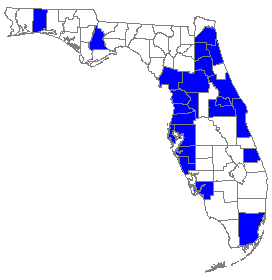 |
 

 |


Cofaqui Giant-Skipper (Megathymus cofaqui [Strecker])
Wing span: 1 15/16 - 2 7/16 inches (5 - 6.3 cm).
Identification: Forewing is relatively short and blunt. Upperside is black; forewing has a broad yellow band that arches inward to the middle of the costa; hindwing has long hairlike scales at the base. Underside of hindwing is gray with small white spots.
Life history: Adults have a swift and strong flight, and rest on the shady side of tree trunks about 3-6 feet above ground. Males probably perch in the morning to wait for receptive females. Females glue eggs singly on leaves of the host plant. The young caterpillar bores into the stem and root and spins a silken tunnel where it feeds and overwinters. A fully-grown caterpillar makes a silken tent which projects from the stalk of the host or from the ground near its base. The tent becomes camouflaged as bits of soil and leaves stick to it, and within, the caterpillar pupates. The chrysalid can move up and down in its burrow.
Flight: One brood in Georgia from July-September; two broods in Florida from March-November.
Caterpillar hosts: Bear grass (Yucca filamentosa), Spanish bayonet (Y. aloifolia), and Small's yucca (Y. smalliana).
Adult food: Adults do not feed, but males sip moisture from mud.
Habitat: Coastal dunes, pinewoods, shrubland.
Range: Two isolated populations: Georgia and the west Florida panhandle, and peninsular Florida.
Conservation: Populations and their habitats should be conserved wherever found.
The Nature Conservancy Global Rank: G3 - Very rare or local throughout its range or found locally in a restricted range (21 to 100 occurrences). (Threatened throughout its range).
Management needs: None reported.
References:
Opler, P. A. and G. O. Krizek. 1984. Butterflies east of the Great Plains. Johns
Hopkins University Press, Baltimore. 294 pages, 54 color plates.
Opler, P. A. and V. Malikul. 1992. A field guide to eastern butterflies. Peterson
field guide #4. Houghton-Mifflin Co., Boston. 396 pages, 48 color plates.
Scott, J. A. 1986. The butterflies of North America. Stanford University Press,
Stanford, Calif. 583 pages, 64 color plates.
Author: Jane M. Struttmann
State and Regional References:
Gerberg, E.J. and Arnett, R.H., Jr. Florida Butterflies. Natural Science
Publications, Inc. Baltimore, MD. 90 pp.
Kimball, C.P. 1965. Arthropods of Florida and Neighboring Land Areas - Vol. 1:
Lepidoptera of Florida. Div. of Plant Industry, State of Florida Dept.
of Agriculture. Gainesville, FL. 363 pp.
Minno, M.C. and Emmel, T.C. 1993. Butterflies of the Florida Keys. Scientific
Publishers. Gainesville, FL. 168 pp.
Opler, P.A. 1998. A field guide to eastern butterflies, revised format.
Houghton Mifflin Co., Boston.
Smith, D.S., Miller, L.D. and Miller, J.Y. 1994. The Butterflies of the West
Indies and South Florida. Oxford Univ. Press. Oxford, U.K. 264 pp.

